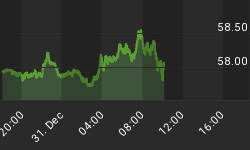It's the same story, but a different week. Investors were buying the "Ben Bernanke has your back story" only 8 weeks ago, but now that the Fed is "all in", there is a curious silence out there as the realization hits that prices are falling and the Fed can't come to the rescue. Funny how the market works. The market should head lower and needs to head lower. The market needs to clear itself of the weak hands. A market that fails to clear itself of the weak hands is a market built upon a poor foundation. But this is the kind of market environment that QE has wrought. First, we had a market that bottomed (July, 2012) when sentiment wasn't too bearish. Historically, such bounces tend to be anemic. Second, as the rally gained steam market participants were finding all sorts of reasons to justify why this rally was the big one. Remember when market participants thought that low volume meant lack of investor interest which interpreted as a bullish contrarian signal? Third, this rally was built upon the speculation of more QE, but when the ultimate QE arrived, the market rolled over. Classic buy the rumor, sell the news. Fourth, QE and monetary policy have been substituting for sound fiscal policy - something that is sorely missing in Washington. QE has distorted markets and wrought a market environment built upon speculation and not on economic fundamentals. And now it is time to pay the piper.
As stated for several weeks now, we will need to see lower prices before finding a meaningful bottom. Anything short of this will be the same old same old. The markets will have failed to clear itself of the weak hands.
The "Dumb Money" indicator (see figure 1) looks for extremes in the data from 4 different groups of investors who historically have been wrong on the market: 1) Investors Intelligence; 2) MarketVane; 3) American Association of Individual Investors; and 4) the put call ratio. This indicator is neutral, and just below the extremely bullish level. Bullish sentiment is unwinding.
Figure 1. "Dumb Money"/ weekly
Figure 2 is a weekly chart of the SP500 with the InsiderScore "entire market" value in the lower panel. From the InsiderScore weekly report: "Insider trading volume was negatively impacted by the unscheduled market closures on October 29th/30th but should begin increasing this week in the wake of the first big round of earnings announcements. Volume has been seasonally light across the market as most companies have closed trading windows, effectively prohibiting insiders from buying or selling until after the release of Q3'12 earnings. This past week, sellers outnumbered buyers by a 5:4 margin market-wide and the top-line sectors showed Neutral sentiment readings."
Figure 2. InsiderScore "Entire Market" value/ weekly
Figure 3 is a weekly chart of the SP500. The indicator in the lower panel measures all the assets in the Rydex bullish oriented equity funds divided by the sum of assets in the bullish oriented equity funds plus the assets in the bearish oriented equity funds. When the indicator is green, the value is low and there is fear in the market; this is where market bottoms are forged. When the indicator is red, there is complacency in the market. There are too many bulls and this is when market advances stall. Currently, the value of the indicator is 68.86%. Values less than 50% are associated with market bottoms. Values greater than 58% are associated with market tops. It should be noted that the market topped out in 2011 with this indicator between 70% and 72%.
Figure 3. Rydex Total Bull v. Total Bear/ weekly
TheTechnicalTake offers a FREE e-newsletter: HERE
Visit TheTechnicalTake website: HERE
















